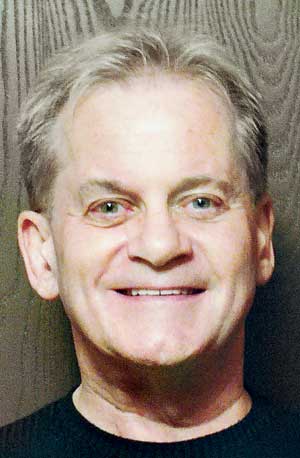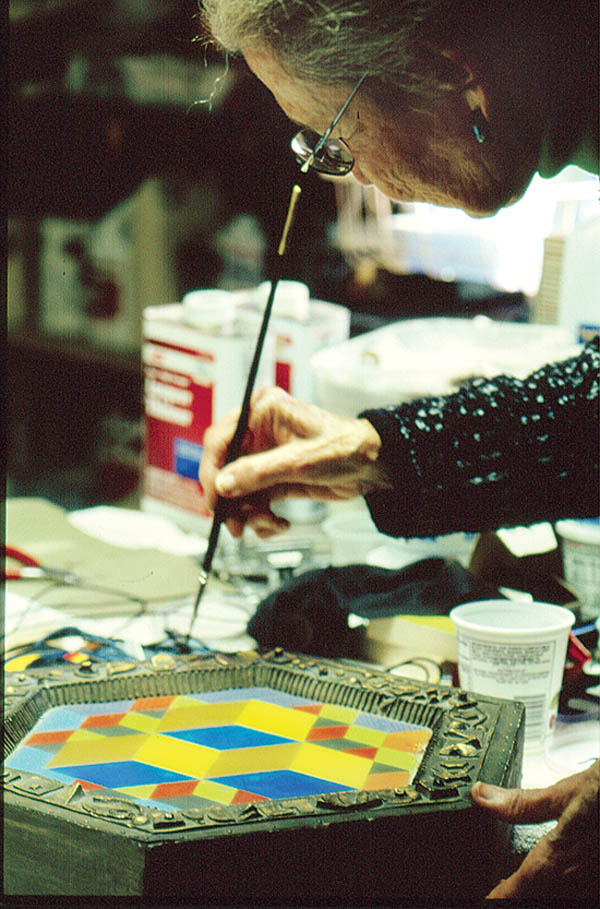The Artistry Of Frances Higgins
Frances Stewart Higgins (1912-2004)
As a little girl growing up in rural Georgia, glass artist Frances Higgins sometimes passed the days constructing "flower viewers". Shed dig shallow holes at random spots along Georgia byways, line them with the heads of colorful wildflowers, then cover each hole with a piece of clear glass. Once earth was smoothed in to cover the glass edges, Frans flower viewers were complete. When folks trudging along dusty Georgia paths encountered them, they received a jolt of unexpected visual pleasure. That was the idea. "Imagine", Fran once told me with a smile, "the looks on their faces."
On December 24, 2012, Frances Higgins would have celebrated her 100th birthday. She spent her life providing the world with jolts of unexpected pleasure, through her work, talent, and captivating personality. It was simply impossible not to like Fran; you wanted to spend as much time as possible in her company. Soft-spoken and genteel, she possessed an underlying determination, and a work ethic that was unshakable. Down South, where she hailed from, they call ladies like Fran "steel magnolias". Its a compliment, and one not bestowed lightly.
When coupled with a larger-than-life personality such as Michael Higgins, her husband and artistic collaborator, Fran could will herself into the background. But that was always a conscious choice. When the mood struck, she could also take center stage and hold your attention for as long as she liked. During the last decade of her life, when I was privileged to be both her friend and biographer, she certainly held mine.
Glassmates
Frances Stewart was born on December 24, 1912 in Haddock, Georgia. She received her undergraduate degree from Georgia State College for Women, and studied at Columbia and Ohio State, before beginning a 14-year teaching career that led to an assistant professorship in art at the University of Georgia. Work on her masters degree resulted in a Rockefeller Foundation Fellowship, and advanced studies at Chicagos Institute of Design. There she was introduced to Michael Higgins, Head of Visual Design.
"Michael was firm in his opinions from the beginning", noted Frances, "but so was I. And he was a very positive person. The people I knew before Michael were not interested in art, but Michael was. He listened to me." Married on December 11, 1948, the couple then left the Institute, beginning their half-century of dual artistry in glass.
Described by art critic Paul Hollister as "forerunners of the American studio glass movement", the Higgins revived and refined the ancient craft of glass fusing. Their "modern miracles with everyday glass" transformed the ordinary, such as bowls, plates and ashtrays, into housewares that were decorative as well as useful. Glowing with color and imagination, Higgins glass attracted buyers by the bushelsful.
Initially based out of their Chicago apartment, Frances and Michael often worked around the clock in split shifts, meeting giftware order deadlines for major retailers that included Marshall Fields and Bloomingdales. Attempting to explain the nearly immediate (and enduring) popularity of Higgins glass, Fran once said, "We just try to make what looks goodanytime, in any place. Things that are lasting, and can be enjoyed for years to come. We dont follow fashion".
From 1957 to 1964, the Higgins were headquartered at Dearborn Glass Company in Bedford Park, Illinois. Adapting handcrafted glass techniques to the demands of mass production, Fran and Michael designed and supervised the creation of Dearborns extensive line of "higginsware". Generally identified by a lower-case "higgins" signature in gold, the Dearborn output brought the Higgins national acclaim, and served as the cornerstone for todays robust Higgins collecting field.
Following a short-lived stint at Dundees Haeger Potteries, the Higgins opted to return to independent studio work. In 1966, they moved to Riverside, Illinois, where the Higgins Glass Studio has been located ever since.
Glasswork
In glass fusing, a drawn or pieced design is "sandwiched" between one or more layers of enameled glass; the glass sandwich is then heated on a mold, where it "slumps" to conform to the molds shape. Although working as a "joint design-personality", Michael and Fran employed different techniques in creating their "unique objects of fused, enameled, molded glass." Michael favored "pieced" fusing, glass segments arranged to form an image within the glass sandwich. Frans "drawn" technique focused on images hand-painted in enamel, on the interior glass panel.
Over the years, however, the Higgins glassmaking repertoire expanded tremendously. Said Fran, "Michael and I kept experimenting, learning by trial and error. We learned from each piece that we made." Among the many innovations credited to Frans ongoing experimentation:
"Dropout" vases: when heated, the glass "drops out" of its ring mold, creating a vase-like shape.
"Flip Art": actual vegetation is tapped in colored pigment, then "flipped" against the glass to create a pattern.
"Frammies": fused glass "paintings", each with its own hand-crafted stamped frame.
Although Michael Higgins died in 1999, Fran never retired, continuing to work in the studio until shortly before her death in 2004, "just doing the same sort of thing I was always doing, but branching out once in awhile." There never seemed to be enough hours in the day to realize all the artistic images that came to her. "I dont know where I get my ideas", she said, "but I get them all the time, for this, that, and the other. It seems to me that they just come like a miracle. I just think Im going to try this, and then I do."
Looking back on her lifes work, Fran once observed "I think I was born with this talent, and just kept looking around until I found the best way to use it. This has been an interesting way to make a living. And even when times were hard, I never gave up. Im not a giver-upper."
Glassified Info
I loved listening to Fran tell stories about her early days, about her work, about what interested herand everything interested her. Even when looking at photos of pieces made at the dawn of her career, she had clear-as-glass memories of each and every one: "heres how we made that". . . ."gosh, that ones pretty". . . .and even, "that piece was hell to do". Her comments were down-to-earth, entertaining, and always informative:
"When I was a young girl, I made all kinds of things. Id make clothes for my dolls. My mother sewed a lot, and I would just drive her crazy. Can I have this scrap? Id say, and shed say wait til I get through, please, Fran."
"My mother was the only one of my family interested in art. She did a drawing of a storm, a big drawing, with the lightning striking and all. It was a good drawing. Shed had eleven art lessons. She used to always say that, I had eleven art lessons. But then she couldnt do any more."
"Michael and I almost starved to death when we first started out. One time a sales agent from New York asked if wed make things for him, but we didnt do so well; our pieces were hard to sell. The agent said, the trouble with you two is you make everything too sophisticated. Youre too far ahead of your time. But we didnt know how to make it differently."
"With our type of work, you have to see not just what you are doing, but what its going to look like when its all done. You have to see that in your mind."
"Im pleased with most of the things Ive made. I dont have favorites, but there are always certain things about certain pieces that I like. Of course, there are some where I think oh, I wish I hadnt done that, I wish I hadnt. But Im not going to tell you which ones! Because really, I dont even remember the ones that arent right. If it doesnt turn out, I go on to something else. When people like what you do, you can do that."
"I didnt think I would live this long, but luckily theres always something new to try. One day, one thing, another day, something else. I just get up in the morning and say, you know, I think Ill give that a try, and I do. Thats how it works."
"When I look back at all the things that we have done, all these different things, sometimes it makes me tired. Because I remember how much work it all was. But mostly I think Im pleased. Pleased with how well everything turned out. Whenever I see a piece of Higgins glass, whether I did it, or Michael did it, or someone else here did it, I always know its Higgins. Everybody else does, too. That makes me just a little bit proud. Just a little bit."
Glass Conscious
"I was at a flea market once, and saw one of our early pieces for sale. I picked it up for a better look, and this saleslady came rushing right over. Be careful, she said, thats Higgins. Its worth plenty. I know, I said. Im Higgins."
Frances Higgins, 2003
Fran always seemed flatteredif at times a bit bewilderedby the attention her work received from collectors. Higgins glass was what Michael and Fran made. Higgins glass collecting was something other people did. She often liked to recount her first exposure to Higgins on eBay. A friend pulled up an ongoing Higgins auction. Frances recognized it as a dish that originally sold for "$2.50 or lessprobably less." On a whim, Frans friend sent an email to the seller: would he like details about the original design of the piece being offered? If so, the designer was right there, observing the auction.
A lively dialogue ensued, with the seller expressing amazement over the items original retail price. A few days after the auction, a letter arrived at the Higgins Studio. Enclosed was a note: "Only $2.50? You deserve much more." Attached was a check. . .for much more than $2.50.
Over the years of our friendship, discussing the many, many items the Higgins Studio produced, I was continually amazed at the diversityfrom dinnerware to jewelry, vases, lamps, window panelseven free-form sculptures. How had an operation initially comprised of just two people managed to not only produce so many different pieces, but also to come up with so many different ideas? "Well," Fran told me, "we had to eat."
"But what about all those ideas?" I asked again. "Where do all the ideas come from?"
"Oh those," said Fran, "I just see them" . . . much as a little girl, so many years ago, saw flowers blooming brightly from the barren Georgia earth.
The Higgins Glass Studio, as per the wishes of Michael and Frances Higgins, continues today under the direction of their longtime design associates Louise and Jonathan Wimmer. The Studio is located at 33 East Quincy St., Riverside, IL 60546 (708-447-2787; www.higginsglass.com)
Donald-Brian Johnson (text) and Leslie Piña (photos) are the co-authors of numerous Schiffer books on mid-twentieth century design, including "Higgins: Adventures in Glass" and "Higgins: Poetry in Glass". Please address inquiries to: donaldbrian@msn.com.
All photos by Leslie Piña, except as noted.

Donald-Brian Johnson
Donald-Brian Johnson is a nationwide columnist, and the co-author of numerous Schiffer books on design and collectibles. His most recent, "Postwar Pop," is a collection of his columns.














